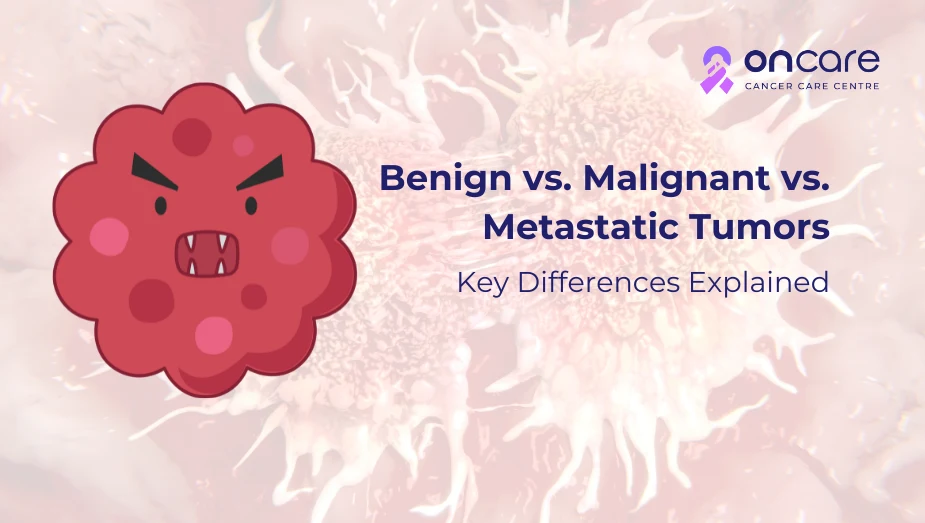Table of Contents
Benign vs. Malignant vs. Metastatic Tumors: Key Differences Explained

The suspicion of a tumor and its diagnosis can often make people nervous. Understanding the tumor’s type and characteristics can make a huge difference in your life, making you prepare for what’s to be expected ahead of the treatments. Understanding the terms benign tumors, malignant tumors, and metastatic tumors and what exactly they mean will help people to determine any suspicions and get timely treatments.
In this blog, we’ll discover more about the key differences between benign, malignant, and metastatic tumors and how they affect the treatment options and their outcomes!
What is a tumor?
A tumor, also referred as neoplasm, is a solid mass of tissue that develops when abnormal cells group together. It can develop anywhere in the body, mainly including the bones, skin, tissue, organs, and glands. There are different types of tumors; one of them is benign, which means it is not cancerous.
In some cases, you may need treatments or no treatment at all. Meanwhile, cancerous and malignant tumors often require cancer treatment.
Benign tumor: Non-cancerous and less dangerous
Benign tumors are non-cancerous growths that develop in the body. These types of tumors are generally localized in nature, which means they do not spread to other parts of the body. These tumors often grow slowly and are also known for their well-defined borders. This makes it very easy to remove the tumors with surgery.
Characteristics of benign tumor
Here are some key characteristics of benign tumors:
- Non-invasive : Benign tumors do not invade nearby tissues or distant organs. These types of tumors often grow within a confined area and do not spread to distant organs.
- Confined : The majority of benign tumors are often surrounded by a capsule, a protective layer that keeps them from affecting surrounding tissue.
- Slow- growing : These tumors typically grow at a slow pace and mostly do not cause any noticeable symptoms until they reach a certain size.
- Rare recur : After the surgical removal of these tumors, the majority of tumors don’t grow back.
- Low risk : In some cases, benign tumors might cause discomfort and complications depending upon the size and location. In most of the cases, these are not life-threatening.
Examples of benign tumors
There are some examples of benign tumors that affect the human body.
These may include:
- Fibroids : These are non-cancerous tumors developed in the uterus that commonly affect women.
- Adenomas : These are tumors developed in glandular tissues like the thyroid or pituitary gland and some other glands as well.
- Lipomas : These are tumors that develop as fatty growths just beneath the skin.
- Meningiomas : These are tumors that grow on the lining of the brain and spinal cord.
Treatment and prognosis
In most cases, the benign tumors are surgically removed if necessary. The majority of these tumors are non-cancerous. These tumors won't spread to other parts of the body. In most cases people diagnosed with benign tumors have experienced a successful prognosis and outcome. These are unlikely to experience the tumor returning after the treatments.
Malignant tumor
Malignant tumors are generally cancerous in nature. It has the potential to grow aggressively, invade nearby tissues, and has the tendency to spread to other parts of the body. Malignant often refers to the tumor’s ability to spread (metastasize), making it more dangerous and hard to treat in patients.
Characteristics of malignant tumors
Here are some key characteristics of malignant tumors.
These may include:
- Invasive : Malignant tumors can often invade surrounding tissues, making them more difficult to treat. It used to disrupt the normal functions of organs and structures they affected.
- Uncontrolled growth : These types of cancer cells often divide uncontrollably and do not spread the body’s normal regulatory mechanisms.
- Poor defined borders : Malignant tumors do not have any clear borders and boundaries, which makes the surgical removal more challenging and difficult in patients.
- Ability to metastasize : These tumors can spread through the bloodstream or lymphatic system to other organs or tissues, forming secondary tumors.
- Potential to life-threatening complications: These are dangerous; if left untreated, then these tumors can be fatal.
Examples of malignant tumors
Here are some of the common examples of malignant tumors.
These may include:
- Lung cancer
- Breast cancer
- Colon cancer
- Leukemia
- Brain cancer (glioblastoma)
Treatment and prognosis
Treatment for malignant tumors often involves a combination of surgery, radiation, chemotherapy, immunotherapy, or targeted therapy depending on the location of the tumor, its stage, and the overall health condition of the patient. Early diagnosis and timely medical intervention significantly improve the chances of survival and successful treatment.
Metastatic tumors
Metastatic tumors, also known as secondary tumors, are cancerous growths that have generally spread from their original site to other parts of the body. When the cancer cells break away from the primary tumor, they may travel through the blood stream or lymphatic system. Later, they might form new tumors in the distant organs.
These types of tumors are still considered to be the same type of cancer as the primary tumor. For instance, breast cancer that spreads to lung cancer is still known as breast cancer.
Characteristics of metastatic tumors
Here are some key characteristics of metastatic tumors in people.
These may include:
- It can spread to other organs
- Aggressive growth
- Same behavior as primary cancer
Examples of metastatic tumors
Here are some examples of metastatic tumors developed in the human body.
These may include:
- Metastatic breast cancer
- Metastatic prostate cancer
- Metastatic melanoma
Treatment and prognosis
Treatment for metastatic tumors focuses on slowing the progression of cancer, reducing the symptoms, and improving the overall quality of patients' lives. While in most cases these tumors are not easily curable. The most used treatments are chemotherapy, immunotherapy, targeted therapies, and palliative care. These treatments are often used to improve the disease.
Key differences of benign, malignant and Metastatic tumors
Here are some accurate characteristics of benign, malignant and metastatic tumors.
Characteristics | Benign tumors | Malignant tumors | Metastatic tumors |
|---|---|---|---|
Growth rate | Slow | Fast (varies) | Rapid growth |
Invasiveness | Non- invasiveness | Invasive | Invasive (spreads to other body parts) |
Spread | Do not spread | It can spread to other parts of the body | Tumors that spread to other parts of the body |
Borders | Well- defined | Poorly defined | Irregular (depending on the site of metastasis) |
Recurrence | Rare after removal | Common after treatment | Common after initial treatment |
Treatment | Surgery required | Surgery, Radiation and chemotherapy | Focusing on controlling symptoms |
Risk | Low, generally non–life threatening | High, can be life-threatening | High, generally more difficult to treat |
Consult Today
Understanding the key differences between benign, malignant, and metastatic tumors is essential for both diagnosis and treatment. Benign tumors are generally non-cancerous in nature and also not life-threatening, whereas malignant tumors are cancerous in nature and can be aggressive, spreading to other parts of the body. Whereas metastatic tumors often refer to cancer that has spread beyond its original location. It makes the treatment look more complex and difficult.
At Oncare, we offer premium-quality cancer treatments, including advanced cancer surgeries at affordable price ranges with an experienced cancer specialist consultation.
If you or any loved ones of yours are diagnosed with cancer, then visit Oncare Cancer Center and book an appointment with our cancer specialists today.Get an estimated cost of cancer treatments today!
Frequently Asked Questions
There are three types of tumors:
- Malignant (cancerous) tumors
- Benign (non cancerous) tumors
- Precancerous tumors
In some cases, tumors cause symptoms like:
- Fatigue
- Fever or chills
- Night sweats
- Loss of appetite
- Unexplained weight loss
- Painful lump
A healthcare professional will perform a biopsy to determine whether a tumor is cancerous or not. Performing a biopsy involves removing the neoplasms. A pathologist examines the lab to make a diagnosis.
You may also get:
- Blood tests
- Imaging tests
Here are some risk factors that increase the risk of developing neoplasm based on the type. These are some general risk factors:
- Gene mutations such as BRCA genes
- Inherited conditions such as lynch syndrome and neurofibromatosis (NFS)
- Family history of breast cancer and prostate cancer
- Smoking cigarettes
- Secondhand smoking
- Excessive alcohol consumption
- Toxic exposure like asbestos and benzene
- Previous radiation exposure
- HPV viruses
- Having obesity
Book an Appointment
Related Blogs

Types of Pancreatic Cancer: Exocrine vs. Neuroendocrine Tumors
Explore more about the types of pancreatic cancer, differences between exocrine and neuroendocrine tumors, diagnostic tests used, and why learning these cancers matters!

Types of Ovarian Cancer: Epithelial, Germ Cell & Stromal Tumors
Discover more about the types of ovarian cancer, epithelial, germ cell, and stromal tumors, and why learning these types matters and the importance of early detection!

